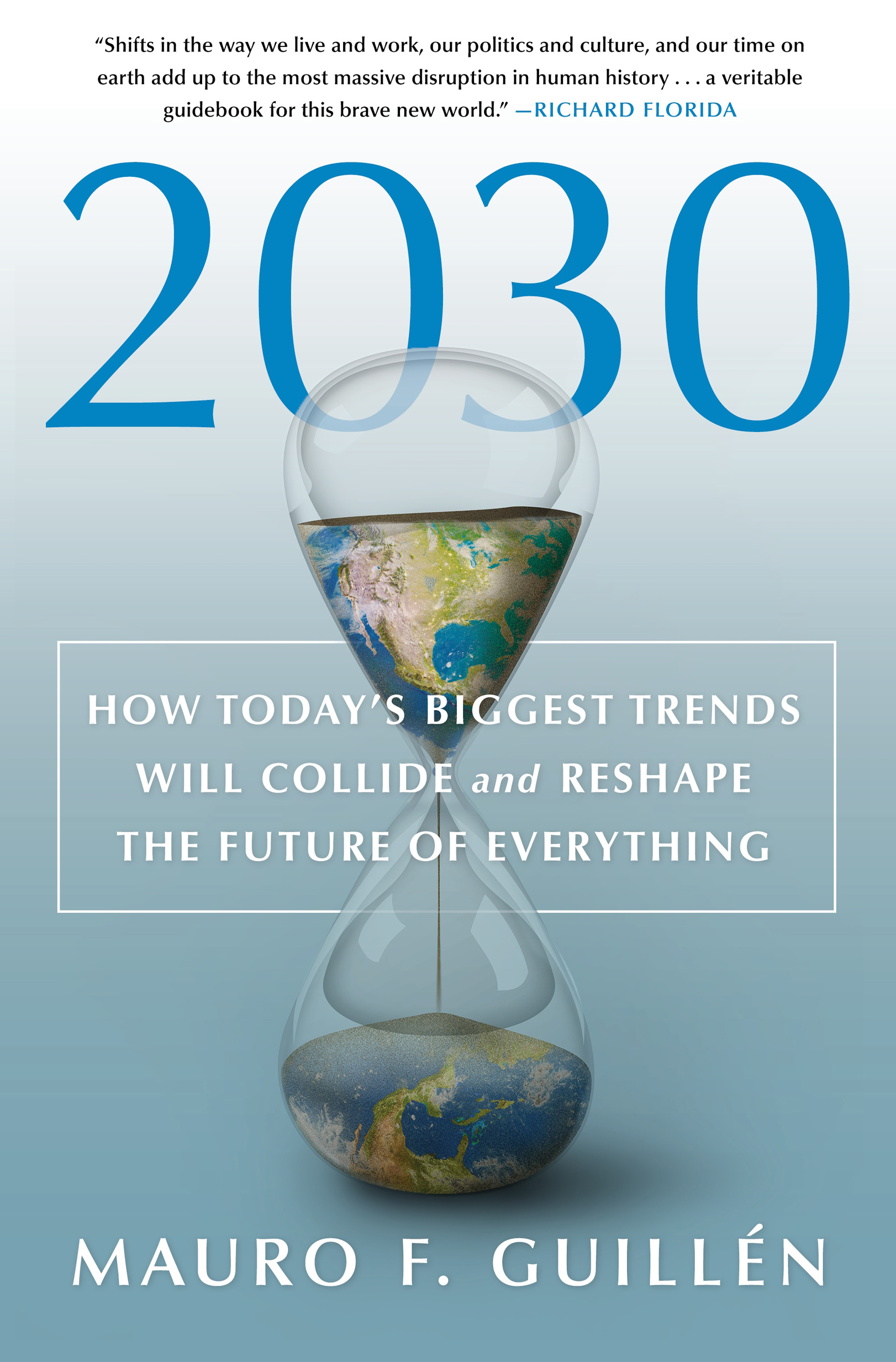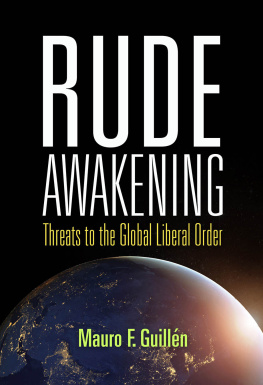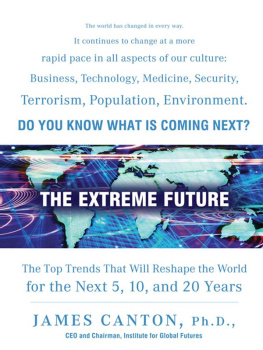Mauro F. Guillen - 2030: How Todays Biggest Trends Will Collide and Reshape the Future of Everything
Here you can read online Mauro F. Guillen - 2030: How Todays Biggest Trends Will Collide and Reshape the Future of Everything full text of the book (entire story) in english for free. Download pdf and epub, get meaning, cover and reviews about this ebook. year: 2020, publisher: St. Martins Publishing Group, genre: Politics. Description of the work, (preface) as well as reviews are available. Best literature library LitArk.com created for fans of good reading and offers a wide selection of genres:
Romance novel
Science fiction
Adventure
Detective
Science
History
Home and family
Prose
Art
Politics
Computer
Non-fiction
Religion
Business
Children
Humor
Choose a favorite category and find really read worthwhile books. Enjoy immersion in the world of imagination, feel the emotions of the characters or learn something new for yourself, make an fascinating discovery.

- Book:2030: How Todays Biggest Trends Will Collide and Reshape the Future of Everything
- Author:
- Publisher:St. Martins Publishing Group
- Genre:
- Year:2020
- Rating:4 / 5
- Favourites:Add to favourites
- Your mark:
- 80
- 1
- 2
- 3
- 4
- 5
2030: How Todays Biggest Trends Will Collide and Reshape the Future of Everything: summary, description and annotation
We offer to read an annotation, description, summary or preface (depends on what the author of the book "2030: How Todays Biggest Trends Will Collide and Reshape the Future of Everything" wrote himself). If you haven't found the necessary information about the book — write in the comments, we will try to find it.
Mauro F. Guillen: author's other books
Who wrote 2030: How Todays Biggest Trends Will Collide and Reshape the Future of Everything? Find out the surname, the name of the author of the book and a list of all author's works by series.
2030: How Todays Biggest Trends Will Collide and Reshape the Future of Everything — read online for free the complete book (whole text) full work
Below is the text of the book, divided by pages. System saving the place of the last page read, allows you to conveniently read the book "2030: How Todays Biggest Trends Will Collide and Reshape the Future of Everything" online for free, without having to search again every time where you left off. Put a bookmark, and you can go to the page where you finished reading at any time.
Font size:
Interval:
Bookmark:


The author and publisher have provided this e-book to you for your personal use only. You may not make this e-book publicly available in any way. Copyright infringement is against the law. If you believe the copy of this e-book you are reading infringes on the authors copyright, please notify the publisher at: us.macmillanusa.com/piracy.
Birthplace of the next industrial revolution: sub-Saharan Africa
The reason: 500 million acres of fertile yet undeveloped agricultural land
The size of Mexico: 500 million acres
Percentage of the worlds wealth owned by women in 2000: 15
Percentage of the worlds wealth owned by women in 2030: 55
If Lehman Brothers had been Lehman Sisters: global financial crisis averted
Worldwide, the number of people who went hungry in 2017: 821 million
Worldwide, the number of people who will go hungry in 2030: 200 million
Worldwide, the number of people who were obese in 2017: 650 million
Worldwide, the number of people who will be obese in 2030: 1.1 billion
Percentage of Americans projected to be obese in 2030: 50
Percentage of the worlds land occupied by cities in 2030: 1.1
Percentage of the worlds population living in cities in 2030: 60
Percentage of worldwide carbon emissions produced by cities in 2030: 87
Percentage of worlds urban population exposed to rising sea levels in 2030: 80
The largest middle-class consumer market today: United States and Western Europe
The largest middle-class consumer market in 2030: China
By 2030, the number of people entering the middle class in emerging markets: 1 billion
The number of people currently in the middle class in the United States: 223 million
The number of people in the middle class in the United States in 2030: 209 million
The Clock Is Ticking
People generally see what they look for, and hear what they listen for.
JUDGE TAYLOR IN HARPER LEES TO KILL A MOCKINGBIRD
The year is 2030.
From Paris to Berlin, Western Europe is unusually warm, with no end in sight to the summers record temperatures, a fact the international press reports with increasing alarm. Rehema has just landed in her native Nairobi on a return flight from London, where she spent a couple of weeks with some distant relatives. She was disappointed to see fewer stores open than during her previous trip, perhaps because so many people had become used to buying online during the pandemic. Seeing Britain through the eyes of immigrants afforded her great insight into the diversity of the world around her. Walking through the Nairobi airport, she reflects on how her homeland differs from Britain, which she found to be behind Kenya in areas like tele-medicine and mobile payments. Later, she jokes with her cousin on the trip home at how strangely the British reacted when she told them she had been attending an online school since she was six, along with most of her neighborhood friends.
Thousands of miles away, Angel is waiting to clear customs at JFK Airport in New York City. In two weeks time, she will begin a two-year master of science program at New York University. As she waits, she reads the days New York Times, which opens with a report that the United States, for the first time in its history, has more grandparents than grandchildrena reality in stark contrast to the situation back home in the Philippines. As it turns out, tens of thousands of American senior citizens, under the care of robots for their basic needs, are renting out spare rooms in their homes to make ends meet, especially since their pensions are no longer providing the financial safety net they once expected. Angel turns to a rather reactionary op-ed decrying the fact that American women now outpace men in terms of their share of wealth, a trend the author somehow finds disturbing for the future of the U.S. economy. Angel has time to read most of the newspaper, as the line for foreigners is long and slow-moving. Meanwhile, the line for citizens and permanent residents is moving quite quickly, and she overhears a conversation detailing how Americans can now clear passport control using some fancy blockchain technology, which is a breakthrough with a wide range of benefits: it can assess a sales tax on goods purchased abroad and arrange for the arrival of a self-driving vehicle shortly after youve retrieved your luggage.
2020: China will be number one at everything.
Thats a phrase one hears frequently nowadays. Another is that the United States and China will battle for global supremacy for the foreseeable future. There is some truth to these statements, but they hardly reveal the whole picture. In 2014, India stunned the world by successfully placing a space probe in orbit around Marsthe first country to accomplish the feat in its maiden attempt. Since the dawn of the space age, fewer than half of the missions launched by the United States, Russia, and Europe have been successful, making Indias accomplishment truly extraordinary. Whats more, the Indian Space Research Organisation made history with the missions low $74 million budget.
Now, exactly how much money should it take to set a satellite orbiting around the red planet? Well, a single space shuttle mission might burn as much as $450 million, and it cost $165 million to produce the movie Interstellar and $108 million to bring The Martian to a theater near you.
The Indians demonstrated that they too have the right stuff, as Tom Wolfe once put it. They showed they are a world-class technological powerhouse and can get things done efficiently and on time. The Mars mission wasnt a fluke. In fact, it was the second time that India had surged ahead of the worlds established superpowers. Back in 2009, its maiden mission to the Moon produced the first evidence of the existence of water, apparently concentrated at the poles and possibly formed by the solar wind, as The Guardian reported. It took NASA ten years to independently confirm Indias finding.
Most of us grew up in a world in which the exploration of the cosmos was an expensive endeavor conceived by rocket scientists, funded by global superpowers with vast resources, and carried out by heroic astronauts and capable mission specialists. The comparative complexity and cost of space missions (and which countries had the capacity to accomplish them) were taken for granted. But that reality is now part of history.
Once upon a time, not only was the world neatly divided into prosperous and backward economies, but babies were plentiful, workers outnumbered retirees, and people yearned to own homes and cars. Companies didnt need to see any farther than Europe and the United States to do well. Printed money was legal tender for all debts, public and private. In school they told us how we were supposed to play the game, and we grew up thinking that the rules would remain the same as we took our first job, started a family, saw our children leave the house, and went into retirement.
That familiar world is rapidly vanishing as we encounter a bewildering new reality driven by a new set of rules. Before we know it there will be more grandparents than grandchildren in most countries; collectively, middle-class markets in Asia will be larger than those in the United States and Europe combined; women will own more wealth than men; and we will find ourselves in the midst of more industrial robots than manufacturing workers, more computers than human brains, more sensors than human eyes, and more currencies than countries.
Font size:
Interval:
Bookmark:
Similar books «2030: How Todays Biggest Trends Will Collide and Reshape the Future of Everything»
Look at similar books to 2030: How Todays Biggest Trends Will Collide and Reshape the Future of Everything. We have selected literature similar in name and meaning in the hope of providing readers with more options to find new, interesting, not yet read works.
Discussion, reviews of the book 2030: How Todays Biggest Trends Will Collide and Reshape the Future of Everything and just readers' own opinions. Leave your comments, write what you think about the work, its meaning or the main characters. Specify what exactly you liked and what you didn't like, and why you think so.









